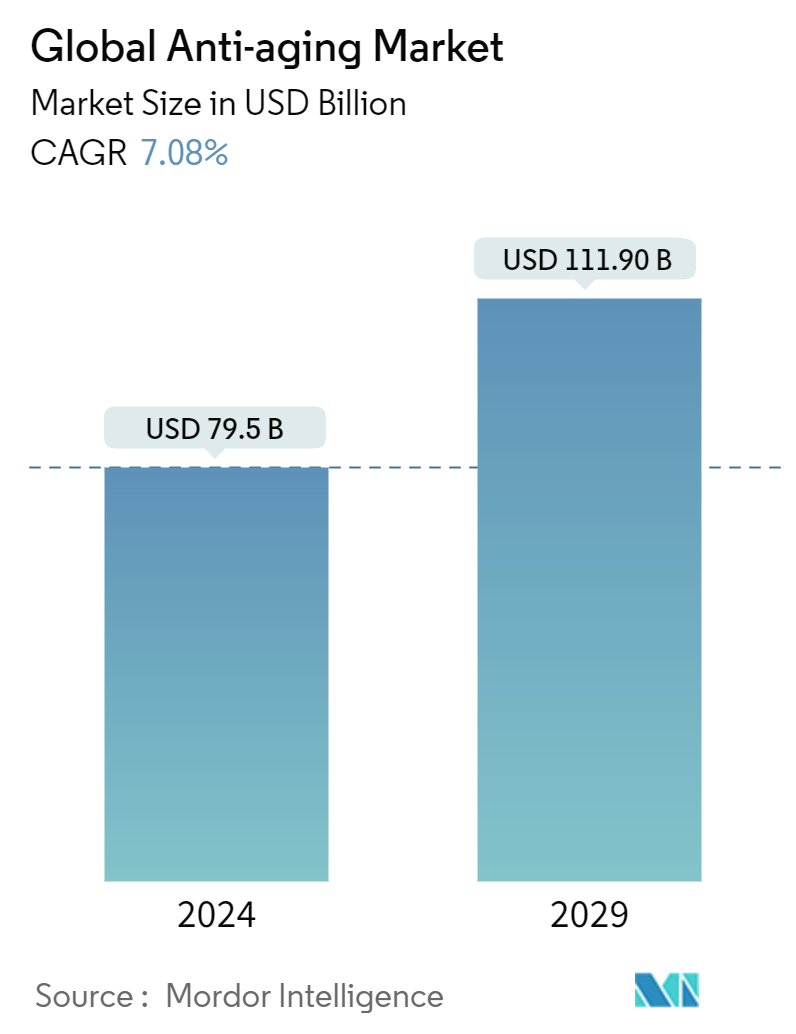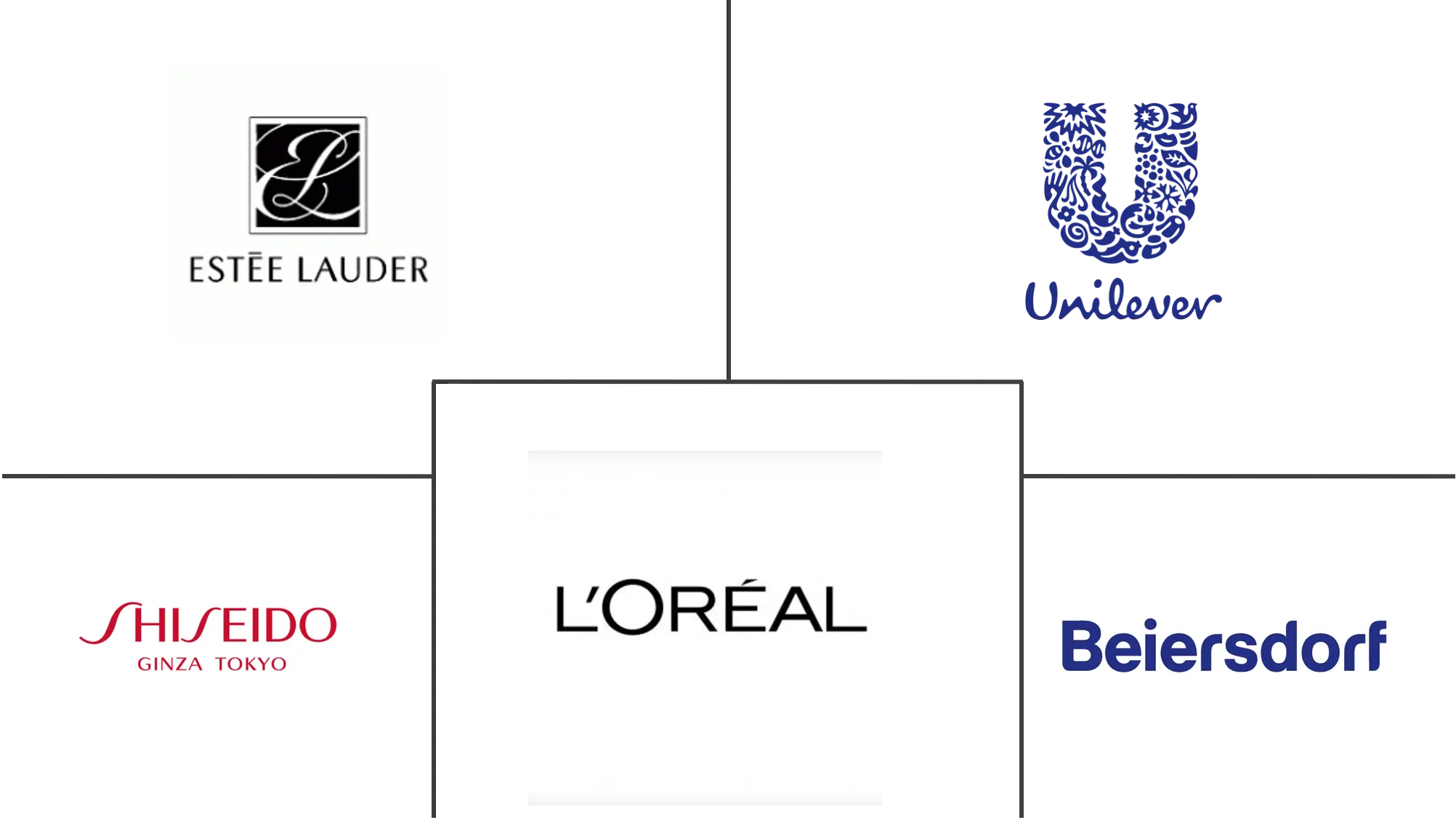Market Size of Global Anti-aging Industry

| Study Period | 2019 - 2029 |
| Market Size (2024) | USD 79.5 Billion |
| Market Size (2029) | USD 111.90 Billion |
| CAGR (2024 - 2029) | 7.08 % |
| Fastest Growing Market | Asia Pacific |
| Largest Market | North America |
Major Players
*Disclaimer: Major Players sorted in no particular order |
Need a report that reflects how COVID-19 has impacted this market and its growth?
Anti Aging Market Analysis
The Global Anti-aging Market size is estimated at USD 79.5 billion in 2024, and is expected to reach USD 111.90 billion by 2029, growing at a CAGR of 7.08% during the forecast period (2024-2029).
The global pandemic of COVID-19 has highly impacted all facets of the healthcare industry. Also, the number of cosmetic procedures during the pandemic period was minimal to none during COVID-19. For instance, the Springer article published in August 2022, mentioned that a 60% reduction in cosmetic surgeries in the pandemic period was recorded Moreover, most elective surgeries were deferred to reduce the COVID-19 infection rate across the world. Thus, the pandemic had a significant impact on the growth of the market. However, the resumption of cosmetic surgeries after the relaxation of strict regulations during the post-pandemic is expected to contribute to the growth of the market over the coming five years.
The rise in the consumer demand for anti-aging solutions, with the increase in lifestyle standards and income among the population across the world, is the major factor driving the growth of the studied market. According to the United Nations World Population Prospects 2022 report, the share of the global population aged 65 years or above is projected to rise from 10% in 2022 to 16% in 2050. Such an increase in the aging population is expected to contribute to the growing demand for anti-aging, thereby contributing to the growth of the market.
Additionally, the rising demand for anti-aging treatments is also expected to contribute to the growth of the market. For instance, the survey conducted by the American Society of Plastic Surgeons in 2022 mentioned that in the United States, 76% of plastic surgeons witnessed increased demand for cosmetic procedures and 23% reported that their business has doubled. The report also mentioned that a facelift is the top cosmetic surgical procedure demanded by patients in 2021-2022.
Additionally, the advancements in technology and increasing investment in the research and development activities by major players for the innovation of highly safe and efficient skin care solutions are expected to propel the anti-aging market globally. Thus, with the rising adoption of anti-aging solutions, there is a potential market for anti-aging devices and aesthetic plastic surgery procedures over the forecast period. However, stringent regulatory policies for the devices and social stigma in some populations are expected to hinder market growth over the forecast period.
Anti Aging Industry Segmentation
As per the scope of the report, skin aging is a complex biological process, influenced by a combination of endogenous or intrinsic and exogenous or extrinsic factors. Because skin health and beauty are considered among the principal factors representing overall well-being in humans, several anti-aging strategies have been developed during the past years. The Anti-aging Market is segmented by Type (Products and Devices), Application (Anti-wrinkle Treatment, Anti-pigmentation, Skin Resurfacing, and Other Applications), and Geography (North America, Europe, Asia-Pacific, Middle-East and Africa, and South America). The market report also covers the estimated market sizes and trends for 17 different countries across major regions, globally. The report offers the value (in USD million) for the above segments.
| By Type | ||||||
| ||||||
|
| By Application | |
| Anti-wrinkle Treatment | |
| Anti-pigmentation | |
| Skin Resurfacing | |
| Other Applications |
| Geography | ||||||||
| ||||||||
| ||||||||
| ||||||||
| ||||||||
|
Global Anti-aging Market Size Summary
The global anti-aging market is poised for substantial growth over the forecast period, driven by increasing consumer demand for anti-aging solutions and advancements in technology. The market's expansion is fueled by rising lifestyle standards and income levels worldwide, alongside a growing aging population, which is expected to boost the demand for anti-aging products and treatments. The resumption of cosmetic procedures post-pandemic is anticipated to further contribute to market growth. However, the market faces challenges from stringent regulatory policies and social stigma in certain regions, which may hinder its progress. The development of innovative and safe skincare solutions through significant investments in research and development by key industry players is expected to propel the market forward.
North America is projected to experience significant growth in the anti-aging market, supported by a well-established infrastructure, the presence of major market players, and favorable demographic trends. The region's growth is further bolstered by the increasing adoption of anti-aging products and procedures, along with supportive reimbursement policies. Companies in North America are actively enhancing their market positions through research and development, new product launches, and obtaining regulatory approvals. The competitive landscape is marked by the presence of numerous domestic and international players, with major companies like L'Oréal, Unilever, and Estee Lauder employing strategies such as acquisitions and partnerships to strengthen their market foothold. Frequent innovative product launches and approvals are expected to drive significant market growth in North America.
Global Anti-aging Market Size - Table of Contents
-
1. MARKET DYNAMICS
-
1.1 Market Overview
-
1.2 Market Drivers
-
1.2.1 Rising Beauty Consciousness in Increasing Aging Population
-
1.2.2 Easy Accessibility of Products and Services
-
-
1.3 Market Restraints
-
1.3.1 Stringent Regulatory Policies and Side Effects Associated With the Products
-
-
1.4 Porter's Five Forces Analysis
-
1.4.1 Threat of New Entrants
-
1.4.2 Bargaining Power of Buyers/Consumers
-
1.4.3 Bargaining Power of Suppliers
-
1.4.4 Threat of Substitute Products
-
1.4.5 Intensity of Competitive Rivalry
-
-
-
2. MARKET SEGMENTATION (Market Size by Value - USD million)
-
2.1 By Type
-
2.1.1 Product
-
2.1.1.1 Anti-wrinkle Products
-
2.1.1.2 Anti-stretch Mark Products
-
2.1.1.3 Hair Color Products
-
2.1.1.4 Other Products
-
-
2.1.2 Devices
-
2.1.2.1 Radio-frequency Devices
-
2.1.2.2 Anti-cellulite Treatment Devices
-
2.1.2.3 Microdermabrasion Devices
-
2.1.2.4 Other Devices
-
-
-
2.2 By Application
-
2.2.1 Anti-wrinkle Treatment
-
2.2.2 Anti-pigmentation
-
2.2.3 Skin Resurfacing
-
2.2.4 Other Applications
-
-
2.3 Geography
-
2.3.1 North America
-
2.3.1.1 United States
-
2.3.1.2 Canada
-
2.3.1.3 Mexico
-
-
2.3.2 Europe
-
2.3.2.1 Germany
-
2.3.2.2 United Kingdom
-
2.3.2.3 France
-
2.3.2.4 Italy
-
2.3.2.5 Spain
-
2.3.2.6 Rest of Europe
-
-
2.3.3 Asia-Pacific
-
2.3.3.1 China
-
2.3.3.2 Japan
-
2.3.3.3 India
-
2.3.3.4 Australia
-
2.3.3.5 South Korea
-
2.3.3.6 Rest of Asia-Pacific
-
-
2.3.4 Middle East and Africa
-
2.3.4.1 GCC
-
2.3.4.2 South Africa
-
2.3.4.3 Rest of Middle East and Africa
-
-
2.3.5 South America
-
2.3.5.1 Brazil
-
2.3.5.2 Argentina
-
2.3.5.3 Rest of South America
-
-
-
Global Anti-aging Market Size FAQs
How big is the Global Anti-aging Market?
The Global Anti-aging Market size is expected to reach USD 79.5 billion in 2024 and grow at a CAGR of 7.08% to reach USD 111.90 billion by 2029.
What is the current Global Anti-aging Market size?
In 2024, the Global Anti-aging Market size is expected to reach USD 79.5 billion.

